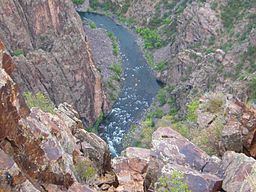- elevation 8,008 ft (2,441 m) Basin area 20,533 km² Discharge 72.77 m³/s | - elevation 4,553 ft (1,388 m) Length 290 km | |
 | ||
- average 2,570 cu ft/s (72.8 m/s) - max 35,200 cu ft/s (996.8 m/s) | ||
Fly fishing the gunnison river black canyon part 1
The Gunnison River is a tributary of the Colorado River, 164 miles (264 km) long, in the Southwestern state of Colorado. It is the fifth largest tributary of the Colorado River, with a mean flow of 4,320 cu ft/s (122 m3/s).
Contents
- Fly fishing the gunnison river black canyon part 1
- Map of Gunnison River Colorado USA
- Our boat trip down the gunnison river
- DescriptionEdit
- HistoryEdit
- FishingEdit
- EngineeringEdit
- References
Map of Gunnison River, Colorado, USA
Our boat trip down the gunnison river
DescriptionEdit
The Gunnison River is formed by the confluence of Taylor and East rivers at Almont in eastern Gunnison County. Just past the town of Gunnison, the river begins to swell into the expanse of Blue Mesa Reservoir, a 36-mile-long (58 km) reservoir formed by Blue Mesa Dam, where it receives the Lake Fork of the Gunnison. Just downstream it is dammed again to form Morrow Point Reservoir, then just downstream of that dam for the final time to form Crystal Reservoir. The reservoirs produce hydroelectric power and supply water for the surrounding areas for both municipal and irrigation use. The reservoirs are the upper part of the Black Canyon of the Gunnison, one of the longest, narrowest, and deepest gorges in the world. Below Crystal Dam it begins to roar through massive cataracts and flows through the deepest part of the gorge. At the outlet of the canyon it receives the North Fork River, then downstream near Delta, Colorado is joined by the Uncompahgre River. It then winds through desert canyonlands, where it receives Kannah Creek before it empties out of the Dominguez Canyon into the Colorado in Grand Junction, some years rivaling the Colorado River for equal if not slightly less volume.
The Gunnison River ranges in width from 100 to 1,000 feet (30 to 305 m) and 3 to 50 feet (1 to 15 m) in depth. The river's powerful current and many rapids make upstream travel nearly impossible. It is navigable for small craft throughout its course and by larger boats below the Black Canyon. Parts of the Black Canyon are non-navigable to any sorts of craft because of giant cataracts. Navigation through the entire canyon is dangerous and for experienced boaters only.
HistoryEdit
The first non-native to see and record information of the Gunnison River was Juan Maria de Rivera, who came to the banks of the river just below its confluence with the Uncompahgre River in 1761 and 1765. It was again seen in 1776 by Silvestre Vélez de Escalante. At the time the Spanish name for the river was Rio de San Javier (Xavier), and the Native American name was Tomichi. Escalante noted that Rivera thought it was "the great Rio del Tizon", the long used Spanish name for the lower Colorado River.
Through the mid-1800s, the river was variously named the Eagle, Eagle Tail, South Fork of the Grand, Grande, and Grand River. Exploration reports and published maps in the 1850s and 1860s most commonly referred to the river as the Grand River. In subsequent years, however, the river was renamed for U.S. Army Captain John W. Gunnison of the Topographic Engineers who was ambushed and killed by Pahvant Utes while mapping a trail west in Utah Territory in 1853.
FishingEdit
The upper section of the Gunnison River is designated as gold medal water and wild trout water. The designation begins 200 yards below the Crystal Dam and stretches through the Gunnison Gorge to the confluence of the North Fork and Gunnison rivers.
EngineeringEdit
Part of the river's water is diverted to irrigate the Uncompahgre Valley via the 5-mile-long (8 km) Gunnison Tunnel, which was built between 1905 and 1909. Dams on the river include Blue Mesa Dam, Morrow Point Dam, and Crystal Dam.
